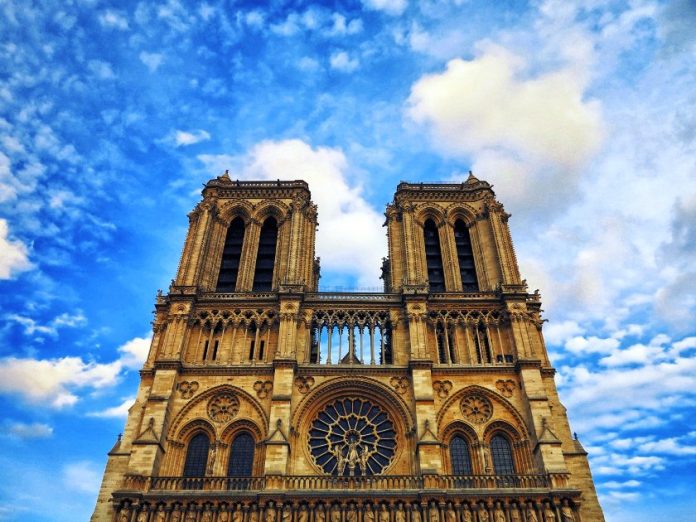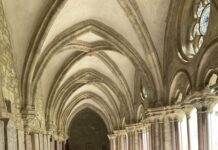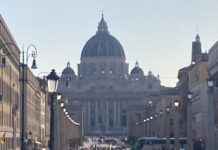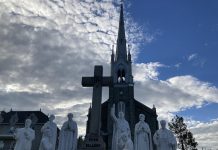“France has been one of the great nations marked by the Christian faith since the dawn of history; and after the fall of the Roman Empire, it was the first nation of the West to declare itself the daughter of the Church, the “eldest daughter of the Church”. For centuries, France made a special contribution to the Catholic Church through the enlightened and heroic testimony of her saints, the doctrinal power of her masters, and the apostolic courage of missionaries …”
John Paul II, May 1980
When Notre Dame de Paris went up in flames one spring evening before the current pandemic descended, the world was transfixed. And worried.
Was the cathedral’s storied magnificence as one of the world’s greatest historical and architectural treasures signalling the firey end of Western civilization itself? Or was the most visited historical monument in Europe, with 13 million visitors each year, simply opening another chapter?
The chapter began shortly after closing time on April 15, 2019. At 18:20, a fire broke out beneath the roof of the cathedral in Paris where renovations were already underway. And by the time the structure fire was extinguished some fifteen hours later, the building’s spire had collapsed. Most of its roof had been destroyed and its upper walls severely damaged. Yet the foundations and the façade, including its exquisite rose window, remained intact. And damage to the interior had been largely prevented by its stone vaulted ceiling which contained the burning roof as it gave way. This meant the medieval treasures adorning the interior were mostly saved –from the splendid stained-glass windows dating back to the Middle Ages and the high altar to the monumental organ, the fourteen side-chapels, the delicate high-reliefs bordering the chancel and even the 14th-century statue of the Virgin and Child which was left pristine despite its proximity to the modernistic altar at the centre of the transept. Ironically, the contemporary altar was destroyed when the shattering spire showered ceiling stones over it, obliterating it from sight and from memory.
Most remarkable, though, was the stark image at the centre of the smouldering devastation – the Cross itself, glowing like gold. And commanding every eye that saw it. And every photo taken by cameramen, firefighters and conservationists surveying the wreckage of this hallowed edifice that for eight hundred years has been at the very heart of France, Holy Mother Church’s eldest daughter and her indelible spiritual and historical witness.
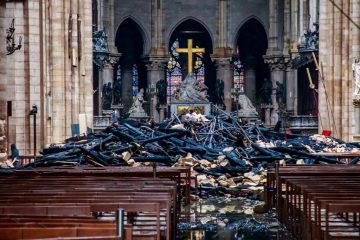
That large and simple cross! What a presence! What an image! What a message! All proclaiming: “This is what this is all about. This is what it has always been about.”
About which, more later ….
Origins of Notre-Dame de Paris
As for the cathedral’s temporal history, academics have long postured that Notre-Dame’s cultural influence and power is derived from its dominance of the Latin Quarter – named after the language spoken by scholars and students who flocked there in medieval times and linking the cathedral with Paris’s emergence as a centre of learning. This was amplified by its proximity to the Louvre, a royal palace that became the world’s largest museum. This helped the new church, then the École cathédrale, establish its legacy of scholarship which in due course merged into the University of Paris, the Sorbonne and its offshoots, all a brief walk away.
Among its early scholars is said to have been Pierre Abelard, France’s first celebrity philosopher. Abelard taught logic and theology there in the early 12th century, attracting admirers from all over Europe and establishing a long literary tradition which over time attracted giants of literature and political thought from Voltaire and Hugo to Marx, Sartre and countless others – prompting the eminent British art historian Kenneth Clark to call Notre-Dame de Paris “the most rigorously intellectual facade in the whole of Gothic art”.
Through it all, the cathedral has been both a prism and a witness to eight centuries of the turbulent spiritual and intellectual history of France.
From its initial commission in 1159 and the laying of its cornerstone in 1163 in the presence of Pope Alexander III on the small island Ile de la Cite in the middle of the River Seine during the reign of King Louis VII, this labour of worship and love was completed in 1345.
Thus began Notre-Dame’s parade through history beginning with the Hundred Years War where the cathedral was host to the crowning of Henry VI, the boy king of England, as king of France in 1431, two years after his coronation at Westminster Abbey in 1429. This was a bid to secure English claims to the throne from across the English Channel. These were also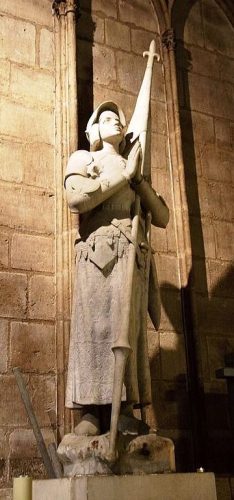 key dates in the protracted war which saw Jeanne d’Arc, the Maid of Orléans, lead the French army to victory over the English at the Siege of Orléans (1428–29) only to be burned at the stake as a heretic by the English in 1431. Yet it wasn’t until 1909 that the saint was beatified by St. Pius X in this very cathedral.
key dates in the protracted war which saw Jeanne d’Arc, the Maid of Orléans, lead the French army to victory over the English at the Siege of Orléans (1428–29) only to be burned at the stake as a heretic by the English in 1431. Yet it wasn’t until 1909 that the saint was beatified by St. Pius X in this very cathedral.
And this very cathedral continued to witness France’s political and religious strife during the 16th century with its fierce Wars of Religion which took their toll on Notre-Dame when in 1548 Huguenot Protestants attacked statues they regarded as sacrilegious. In 1572, the future Henri IV, a Huguenot who sought to end the bloodshed, married the Catholic princess Marguerite de Valois, in front of the cathedral – although Henri did not enter the building. But nor did the symbolic reconciliation on Notre-Dame’s doorstep last. Within days, thousands of Protestants who’d flocked to Paris to attend the wedding were slaughtered by Catholics in the infamous St. Bartholomew’s Day massacre.
Notre-Dame has hosted many other famous royal weddings as well: James V, king of Scotland, married Madeleine of Valois there in 1537; Mary, Queen of Scots married her first husband (Francis, Dauphin of France) at Notre-Dame in 1558; and King Charles I of England married Henrietta Maria of France, in front of Notre-Dame by proxy in 1625, shortly after his accession to the throne. And in 1804, Napoleon I and Josephine were crowned as emperor and empress of France at Notre-Dame.
The Trauma of Revolution
But Napoleon’s nuptials came years after the cathedral was forced to play a central role in what many regard as France’s greatest physical and spiritual trauma: the French Revolution. Preceded by the so-called Enlightenment led by Voltaire and other intellectuals in the mood for dethroning God, the revolution began officially in 1789. Leading the onslaught were Robespierre, Marat, Saint-Just and the Jacobins, the radical revolutionaries who plotted the downfall of the king and the rise of the French Republic. Soon their Reign of Terror was brutalizing Notre-Dame, just as it brutalized the entire country with the guillotining of the king and queen, Louis XVI and Marie Antoinette and countless aristocrats, all members of the much loathed Ancien Regime.
During the revolution, church bells were removed across the country. In 1791, Notre-Dame’s bells were melted down and in 1793, the statues of 28 kings on the cathedral’s façade were decapitated.
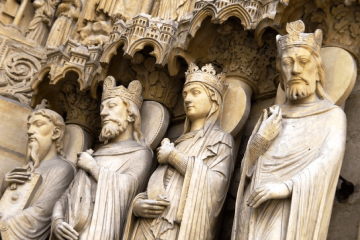
Later that year religion was banned outright and Notre-Dame was converted into an atheist ‘Temple of Reason’ dedicated to the Cult of Reason and the new revolutionary ideals as replacements for Christianity, all signified by a young woman declared its goddess. And all in turn dedicated to the belief that man’s mind was in no need of divine revelation or the moral authority of God. Yet something quite unexpected happened. After all the carnage, and despite the initial excitement over France’s false liberation, the Jacobins and their leaders ended on the guillotine too. And because the defiled and repurposed cathedral was failing to attract worshippers to the new shrine to Liberté, égalité, fraternité (which became the nation’s motto), it was eventually turned into a food warehouse and languished until it was returned to the Catholic Church in 1802. This came after Bonaparte made peace with the Vatican and the cathedral was reconsecrated and offered its first Christmas Mass since the revolution in 1803. A tradition which, sadly, ended with the fire in 2019.
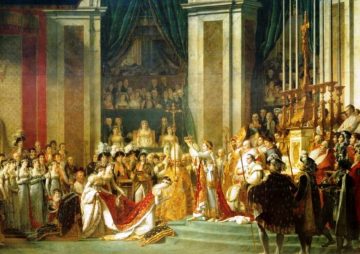 It was also here that Napoleon was crowned emperor in 1804, with Pope Pius VII in attendance. Bonaparte chose Notre-Dame over the cathedral in Reims where French kings were traditionally crowned to make a formal break with the past. Thus Paris, not Reims or Versailles, became the centre of his world with Notre-Dame at the centre of it, though his favour did little to restore her fortunes.
It was also here that Napoleon was crowned emperor in 1804, with Pope Pius VII in attendance. Bonaparte chose Notre-Dame over the cathedral in Reims where French kings were traditionally crowned to make a formal break with the past. Thus Paris, not Reims or Versailles, became the centre of his world with Notre-Dame at the centre of it, though his favour did little to restore her fortunes.
Hugo and Marx
That stroke of fortune came three decades later from the pen of Victor Hugo whose hugely popular 1831 novel The Hunchback of Notre Dame breathed new life into the cathedral by casting the building as a character. This, in turn, led to a nationwide campaign to renovate it. The restoration, between 1844 and 1864, returned the cathedral to its former glory.
Still, the latent seeds of revolution were continuing to sprout in France, this time from the work of Karl Marx who the Paris Commune made famous in 1871 after workers in Paris seized control of their city. When some communards were killed by French troops two months into their siege, the press sought a dangerous communist to blame.
They found him in Marx, a German exile from the 1848 revolutions who had found refuge in London and who was rumoured to have given secret commands to the workers of Paris which journalists were soon calling Marx’s home. Marx was delighted. At long last, his lifelong dream – the working class in power – appeared to be materializing. Apparently Marxism was an idea whose time had come, an idea which would gain power savagely and exponentially into and throughout the 20th century, all the way to the present day along with its fundamental challenge to Christianity itself.
Marx’s Communist Manifesto posed a direct challenge to the Holy Bible and its teachings on the God-created nature of man and his world. In abject contrast, the atheistic Marx believed that man was not a responsible moral creature but rather a ‘reflector’ of his evil capitalistic economic environment. He taught therefore that once Communists got control of the entire world and abolished private property and free enterprise and eliminated the bourgeoisie that man would be dramatically transformed by the socialistic environment. A perfect world would result. Or so he and his followers supposed.
1917 onwards
And that idea quickly infected the entire world. Since then it has become a rival and enemy of Christianity and Holy Mother Church, just as Our Lady of Fatima predicted in 1917, at the precise hour when the world was suffering the horrors of World War I and Bolshevism was about to take over Russia.
Notre-Dame was witness to all of this – through two devastating world wars to the traumatic political violence and unrest of 1968 which was occurring literally a cobblestone’s throw away. Yet she escaped unscathed and again became the focus for subsequent historical ceremonies.
An official Mass was celebrated there to mark the end of World War One. And following the liberation of Paris from the Nazis in August 1944, General de Gaulle attended a similar service after marching with his troops down the Champs-Élysées. When he died in 1970, a memorial service attended by heads of state from around the world was held at Notre-Dame. François Mitterrand, who died in 1996, was the only other former French president to be honoured in the same way.
Yet central to this historical odyssey has been the long and lone struggle for the soul of mankind, always at war with his fallen nature, its greed, its concupiscence and its incessant craving for the escapes, luxuries and comforts of this world. Yet man’s soul also craves the spiritual power and consolation Notre-Dame has long represented and offered. Which is why the world was so shocked by the fire which appeared to threaten the eternal permanence Notre-Dame had so long symbolized. Christendom had again been shaken.
“Christendom has had a series of revolutions and in each of them Christianity has died,” wrote G.K. Chesterton in The Everlasting Man. “Christianity has died many times and risen again; for it had a God who knew the way out of the grave.”
Christianity’s persecution has escalated dramatically in recent years as well, though this ugly phenomenon is still largely ignored and treated as inconsequential. And more than usual, it appears, during this Time of Covid when the 2019 fire resulted in Notre Dame’s first failure to offer Holy Mass at Christmas since 1803. Plus, little attention is being paid to the number of churches being vandalized and desecrated in France and across Christendom, all reminiscent of the lead up to the French Revolution. These attacks appear to be increasing and intensifying too, as religious processions are occasionally attacked by black-clad, far-left ‘antifas’. Crosses are broken, altars are smashed, churches and Bibles are set on fire, church doors are smeared with graffiti and even priests are killed. Most recently, Fr. Olivier Maire, the local provincial superior of the Montfort Missionaries, a worldwide religious congregation founded by St. Louis-Marie Grignion de Montfort, was murdered in August in Saint-Laurent-sur-Sèvre, a commune in the Vendée department in western France which suffered so much persecution and martyrdom at the hands of the Jacobins during the French Revolution.
So it’s not surprising that although the fire at Notre-Dame was declared ‘accidental’, many suspect it was otherwise.
The Disease of Liberalism
Yes, the Cathedral of Notre-Dame is a magnificent structure, but all the money being donated to rebuild it won’t fix Europe’s spiritual problem. Which has long been its rebellious liberalism which is nothing more or less than a distraction from and even a denial of the central event of all human history – the birth of Our Lord and Saviour, Jesus Christ, and His crucifixion on the cross at Calvary and His resurrection – all for the salvation of man from his fallen nature and for his return to the Trinity God Who created him.
The liberalism of the past two centuries appears also to be the fulfillment of St. Paul’s prediction about the latter days: “For there shall be a time when they will not endure sound doctrine, but, having itching ears, they will heap to themselves teachers according to their own desires, refusing to listen to the truth in order to turn to fables. But you, be vigilant, know how to endure sufferings, do the work of an evangelist, fulfill your ministry.” (2Tim 4:3)
Moreover, the truth of St. Paul’s words has long been honoured in their very breach which history confirms daily by the deepening horrors of today’s cultural morass.
For now, French president Emmanuel Macron says he expects France’s beloved cathedral to reopen for the Olympics in 2025, though it is expected to take up to twenty years for final completion. Yet barring a national religious conversion back to orthodox Catholicism and its civilizing traditions, the reconstruction of Notre-Dame looks set to undermine its original spiritual purpose – for the glory, praise and honour of God – if rumours of her reconstruction actually materialize.
Controversy surrounding the Restoration
While traditionalists such as Elizabeth Lev have been calling for a complete restoration of every detail as it was before the fire, there have been reports of what many fear will be a modernistic ‘wreckovation’ springing from blueprint master, Fr. Gilles Drouin. LifeSiteNews Paris correspondent Jeanne Smits has described Fr. Drouin as a teacher of liturgy and an enthusiastic detractor of the traditional rite and a supporter of Traditionis Custodes, which seeks the demise of the Latin Mass. Smits writes: “His comments on the future refurbishing of the interior space of Notre Dame had already shown that his intent is to remodel the way people ‘participate’ in the liturgy. The man who is aiming to revolutionize the interior of Notre Dame is a modernist ideologue.”
This suggests that for France – as for the rest of the western world – there will be no respite yet from the ongoing and delusional disease of liberalism long afflicting it.
As with all ideologies, the carefully hidden purpose of liberalism, particularly communism, is to deny the reality of God and live one’s life as if He doesn’t exist. And as if His Birth, His Cross and Resurrection weren’t at the eternal intersection of life, history and eternity. Which, for the denier, means an unfulfilling life of distraction, denial, destruction and damnation. This false faith also includes the deliberate attempt to deny, obliterate and/or circumvent the natural law itself and its intrinsic order and the bounty it confers in this world – through media propaganda and through politics and through legislation. This is what it means to live a lie. As the world appears to be doing today.
To me, the key to all this is the Cross which is the reason for the Cathedral in the first place. And which is a testament to the Gospel that “God so loved the world that He sent His only begotten son, so that whoever believes in Him may not perish but may have eternal life.” (John 3:16).
The Cross

That life itself is created by God is as undeniable as its joys and sufferings, particularly the sufferings, as described by St. Thomas a Kempis in his Imitation of Christ. This is signified by the Cross itself which is eternal and signifies the redemption of all of Mankind through the suffering and death of Jesus Christ. The very Cross which asserted itself during the fire at Notre-Dame and which can never be forgotten for long! Why? Because regardless of how much humanity tries to avoid it and deny it, there it is for each of us. The Cross. Which the Lord Jesus instructs us: “Take up thy cross and follow Me.” The is the ultimate reality and the ultimate truth from which there is no escape.
Just He instructs Thomas a Kempis:
Behold the cross is all, and in dying to thyself all consists, and there is no other way to life and of true internal peace but the holy way of the cross and of daily mortification.
Dispose and order all things according as thou wilt and as seems best to thee, and thou wilt still find something to suffer, either willingly or unwillingly, and so thou shalt still find the cross.
For either thou shalt feel pain in the body, or sustain in thy soul tribulation of spirit.
Neither canst thou be delivered or eased by any remedy or comfort, but as long as it shall please God thou must bear it.
The cross, therefore, is always ready and everywhere waits for thee. Thou canst not escape it, whithersoever thou runnest; for whithersoever thou goest thou carriest thyself with thee, and shalt always find thyself. Turn thyself upwards, or turn thyself downwards; turn thyself without, or turn thyself within thee, and everywhere thou shalt find the cross. And everywhere thou must of necessity have patience, if thou desirest inward peace and wouldst merit an eternal crown.
It’s not hard to understand why the world seeks to reject such a message and runs in the other direction, denying God’s very existence while hoping to live a life of mindless oblivion, dedicated to total pleasure and self-indulgence in order to blot out the pain of fallen human nature and the Truth of the Cross which remains indelible in every human heart. This was always the struggle at the very heart of all of human history.
And no amount of denial or self-deception can alter it.
May the Lord God bless us all this Christmas and may He forgive our stubbornness, selfishness, disbelief and ingratitude which is precisely why the current darkness continues to descend and deepen across God’s green earth.

